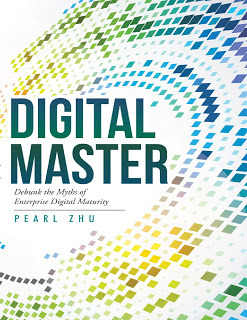Pearl Zhu's Blog, page 1399
October 5, 2015
Which is the Most Critical Factor in Strategy Analysis
It is important to strive for a good understanding of all macro-environmental factors in order to ensure robust planning.
 A PESTEL analysis is a framework or tool used by marketers to analyze and monitor the macro-environmental (external marketing environment) factors that have an impact on an organization. The result of which is used to identify threats and weaknesses which are used in a SWOT analysis. (Professionalacademy.com). P – Political, E – Economic, S – Social, T – Technological, E – Environmental, L – Legal, which factor in the PESTEL is most important in external environment though?
A PESTEL analysis is a framework or tool used by marketers to analyze and monitor the macro-environmental (external marketing environment) factors that have an impact on an organization. The result of which is used to identify threats and weaknesses which are used in a SWOT analysis. (Professionalacademy.com). P – Political, E – Economic, S – Social, T – Technological, E – Environmental, L – Legal, which factor in the PESTEL is most important in external environment though?
Based on contingency theory, it depends on. It means that you should assess in which condition and context you are doing business. In recent days, the technological advancement is pressuring the firms more than other factors. The economic factor is significant because an organization needs to understand the market in which it will be selling its product and service. The political factor also plays an important role in the external environment. It needs to understand what the demand is for its product or service, and what its competitors are doing. Users' access to quality external information is often restricted because of the cost and time needed to collate it. Assumptions often form the basis for most of the data used, making any decision made based on such data subjective. Secondly, on the question of which is the most important factor in PESTEL is dependant on: 1) The industry or sector the company is operating in. 2) The country where it's operating. 3) In which stage of the boom-bust cycle, the industry is at. 4) The most important external factor is the competition.
The PESTLE is a basic footprint for investigative action to be taken. It is applicable to any organization to a greater or to a lesser extent, pending organizational line of business, client needs, demographic regions, competitors, availability of resources, global presence, etc. Due to variation in organizational composition within the global economic arena, one may find that the application of the PESTLE may be differently interpreted from organization to organization, influenced by the latter factors. Hence, it is a tool that highlights or reminds of areas of importance to consider during strategic planning in the organization. There are some limitations of PESTEL: Users can oversimplify the information that is used for making decisions. The process has to be conducted regularly to be effective and often organizations do not make this investment. Users must not succumb to 'paralysis by analysis' where they gather too much information and forget that the objective of this tool is the identification of issues so that action can be taken.
 It is important to strive for a good understanding of all macro-environmental factors in order to ensure robust planning. There is no single most important factor in the PESTEL framework. Depending on the subject to be analyzed, different factors may be supportive or detrimental. There is something that is most important in strategy formulation - knowing your company, knowing your competition, and knowing your customer. If you know these things well, you'll be successful. The other factors must be considered to ensure wise decisions are made when conditions change. Organizations often restrict who is involved due to time and cost considerations. This limits the technique's effectiveness as a key perspective may be missing from the discussions. The people piece is a necessity in analyzing your customer and market segmentation. If you talk to your customers, it's pretty easy to glean what they are looking for in your products/services. It is then that decide how your strategy, in light of all the other factors - especially competition, is to be implemented to differentiate one's organization from your competition.
It is important to strive for a good understanding of all macro-environmental factors in order to ensure robust planning. There is no single most important factor in the PESTEL framework. Depending on the subject to be analyzed, different factors may be supportive or detrimental. There is something that is most important in strategy formulation - knowing your company, knowing your competition, and knowing your customer. If you know these things well, you'll be successful. The other factors must be considered to ensure wise decisions are made when conditions change. Organizations often restrict who is involved due to time and cost considerations. This limits the technique's effectiveness as a key perspective may be missing from the discussions. The people piece is a necessity in analyzing your customer and market segmentation. If you talk to your customers, it's pretty easy to glean what they are looking for in your products/services. It is then that decide how your strategy, in light of all the other factors - especially competition, is to be implemented to differentiate one's organization from your competition.
After all, the PESTLE may just be one of a number of stepping stones serving management to make informed strategic decisions in view of optimization of the organization to create superiority of product through ambiguity in the arena of competition. This should ideally result in establishing a sustainable differentiation from market rivals, something that may be easier said than done.
Follow us at: @Pearl_Zhu
 A PESTEL analysis is a framework or tool used by marketers to analyze and monitor the macro-environmental (external marketing environment) factors that have an impact on an organization. The result of which is used to identify threats and weaknesses which are used in a SWOT analysis. (Professionalacademy.com). P – Political, E – Economic, S – Social, T – Technological, E – Environmental, L – Legal, which factor in the PESTEL is most important in external environment though?
A PESTEL analysis is a framework or tool used by marketers to analyze and monitor the macro-environmental (external marketing environment) factors that have an impact on an organization. The result of which is used to identify threats and weaknesses which are used in a SWOT analysis. (Professionalacademy.com). P – Political, E – Economic, S – Social, T – Technological, E – Environmental, L – Legal, which factor in the PESTEL is most important in external environment though?
Based on contingency theory, it depends on. It means that you should assess in which condition and context you are doing business. In recent days, the technological advancement is pressuring the firms more than other factors. The economic factor is significant because an organization needs to understand the market in which it will be selling its product and service. The political factor also plays an important role in the external environment. It needs to understand what the demand is for its product or service, and what its competitors are doing. Users' access to quality external information is often restricted because of the cost and time needed to collate it. Assumptions often form the basis for most of the data used, making any decision made based on such data subjective. Secondly, on the question of which is the most important factor in PESTEL is dependant on: 1) The industry or sector the company is operating in. 2) The country where it's operating. 3) In which stage of the boom-bust cycle, the industry is at. 4) The most important external factor is the competition.
The PESTLE is a basic footprint for investigative action to be taken. It is applicable to any organization to a greater or to a lesser extent, pending organizational line of business, client needs, demographic regions, competitors, availability of resources, global presence, etc. Due to variation in organizational composition within the global economic arena, one may find that the application of the PESTLE may be differently interpreted from organization to organization, influenced by the latter factors. Hence, it is a tool that highlights or reminds of areas of importance to consider during strategic planning in the organization. There are some limitations of PESTEL: Users can oversimplify the information that is used for making decisions. The process has to be conducted regularly to be effective and often organizations do not make this investment. Users must not succumb to 'paralysis by analysis' where they gather too much information and forget that the objective of this tool is the identification of issues so that action can be taken.
 It is important to strive for a good understanding of all macro-environmental factors in order to ensure robust planning. There is no single most important factor in the PESTEL framework. Depending on the subject to be analyzed, different factors may be supportive or detrimental. There is something that is most important in strategy formulation - knowing your company, knowing your competition, and knowing your customer. If you know these things well, you'll be successful. The other factors must be considered to ensure wise decisions are made when conditions change. Organizations often restrict who is involved due to time and cost considerations. This limits the technique's effectiveness as a key perspective may be missing from the discussions. The people piece is a necessity in analyzing your customer and market segmentation. If you talk to your customers, it's pretty easy to glean what they are looking for in your products/services. It is then that decide how your strategy, in light of all the other factors - especially competition, is to be implemented to differentiate one's organization from your competition.
It is important to strive for a good understanding of all macro-environmental factors in order to ensure robust planning. There is no single most important factor in the PESTEL framework. Depending on the subject to be analyzed, different factors may be supportive or detrimental. There is something that is most important in strategy formulation - knowing your company, knowing your competition, and knowing your customer. If you know these things well, you'll be successful. The other factors must be considered to ensure wise decisions are made when conditions change. Organizations often restrict who is involved due to time and cost considerations. This limits the technique's effectiveness as a key perspective may be missing from the discussions. The people piece is a necessity in analyzing your customer and market segmentation. If you talk to your customers, it's pretty easy to glean what they are looking for in your products/services. It is then that decide how your strategy, in light of all the other factors - especially competition, is to be implemented to differentiate one's organization from your competition.
After all, the PESTLE may just be one of a number of stepping stones serving management to make informed strategic decisions in view of optimization of the organization to create superiority of product through ambiguity in the arena of competition. This should ideally result in establishing a sustainable differentiation from market rivals, something that may be easier said than done.
Follow us at: @Pearl_Zhu
Published on October 05, 2015 23:19
October 4, 2015
The Ultimate Goal of Agile Transformation
The overall goal of adopting a more "Agile" approach is "resilience," in essence.
 Many forward-thinking organizations are scaling their Agile practices from doing Agile to being Agile, what’s the business value in being agile though? And what are the well-defined goals of Agile transformation? From doing Agile to being agile, what are the principles, practices, and crucial steps in managing such transformation?
Many forward-thinking organizations are scaling their Agile practices from doing Agile to being Agile, what’s the business value in being agile though? And what are the well-defined goals of Agile transformation? From doing Agile to being agile, what are the principles, practices, and crucial steps in managing such transformation?
What is the goal of an Agile transformation? It's to change what the organization currently values in regards to process. Look at transformation goal as more an enterprise strategic decision for the organization to achieve goals related to financial, market etc. And common understanding is an essential input towards this transformation. But both of these are just dreams to achieve without the mindset change. As organizations go through this process they need to understand the currency for change that exists in their organization. If you do all of this successfully then you have a shot of adding true innovation into your culture. Just like any agile delivery, the transformation to agile is about "Our highest priority is to satisfy the customer through early and continuous delivery of valuable software." The purpose of agile is to provide value to the business by delivering a product that is beneficial to end users, either internal or external customers. The risks in any effort are, that the effort does not produce any end user benefit, that the effort is actually detrimental to the end user, and that the effort incurs more cost than the value returned to the business.
If you want to transform the organization, you need to change the mindset and the culture. Mindset held by one or more people is a set of assumptions, experiences, and etc that is used as reasons to do things. Often it’s important to adjust the mindset in order to show the benefits of having a common understanding. If there is not a common understanding then there is more than one mindset to change. Even where people disagree, they really ought to understand why and what they are disagreeing with. Then you can value different opinions and take advantage of them. The construct of the question indicates exclusivity between the two. In fact, they are connected. Many organizations are struggling because they have no common understanding across the board, regardless of methodology, due to their overall culture or mindset. Common understanding can be at many levels. From surface interesting facts understanding to deeper cause-effect reasoning. It's the deeper ones that change the mindset. And it has to be explained from many perspectives thereby, it will create a better model in someone's mind, and explain agility from the user, market, economic, techniques, work-life-balance, culture/social and so forth. The mindset change has to do with understanding that doing things differently will bring about that goal more effectively.
 The overall goal of adopting a more "Agile" approach is "resilience," in essence. The twin goals of an Agile transformation are to increase value received and decrease risk. An organization at any scale that can retain an overall sense of vision and purpose, can communicate effectively, continuously improve, reflect on its own limitations honestly and respond to change dynamically. It is simply more likely to thrive and survive. Overly rigid organizational structures - fixed plans, processes, and purposes -cause an organization to resist (external) change up to a point, but eventually the stresses become too large and failure is inevitable. There are many corporate examples of this - where organizations are unable to adapt to major disruptive change because of their rigid inflexibility and lack of agility. You need to understand the difference between adoption and transformation. Getting teams to adopt Scrum and start doing that well is one small part of what a transformation requires.Think of it this way, Scrum teams are like lots of small cogs spinning together, as they mature that start spinning faster and in and of themselves they spin smoothly with no outside friction. However, once you engage a larger cog in the form of a larger component then you have friction. Teams are moving fast than organizations tend to which causes breaks in one or more of the cogs.
The overall goal of adopting a more "Agile" approach is "resilience," in essence. The twin goals of an Agile transformation are to increase value received and decrease risk. An organization at any scale that can retain an overall sense of vision and purpose, can communicate effectively, continuously improve, reflect on its own limitations honestly and respond to change dynamically. It is simply more likely to thrive and survive. Overly rigid organizational structures - fixed plans, processes, and purposes -cause an organization to resist (external) change up to a point, but eventually the stresses become too large and failure is inevitable. There are many corporate examples of this - where organizations are unable to adapt to major disruptive change because of their rigid inflexibility and lack of agility. You need to understand the difference between adoption and transformation. Getting teams to adopt Scrum and start doing that well is one small part of what a transformation requires.Think of it this way, Scrum teams are like lots of small cogs spinning together, as they mature that start spinning faster and in and of themselves they spin smoothly with no outside friction. However, once you engage a larger cog in the form of a larger component then you have friction. Teams are moving fast than organizations tend to which causes breaks in one or more of the cogs.
"Transformation is one thing. The state 'to be' is quite another. By definition if it's transforming from a state to another, it means that one is acquiring a whole set of other things quite different from what they currently have. The driver for transformation would differ from organization to organization based on what the specific problem they're trying to solve is. It is that desired state to be that determines what the mode of the ecosystem of delivery would be. The agile way of working happens to be one of those states. If the transformation is to the agile way of working, then the learning of, shift to and conscious use of empiricism to drive development, surgical and critical focus on value delivery, the practice of collaboration, reflection, constant learning and retrospection away from and in most cases diametrically opposed to disconnected, impersonal practices. Sometimes, efficiency can be overrated. If the objective is to out-innovate the competition, and inefficiency and internal chaos creates the dynamic for creativity and innovation you might win the competition. Being competitive can have an innovation component, a new capability that unlocks a new market/revenue stream, or a cost saving component (fewer people needed to generate the revenue or reduced cost of expansion; prioritizing between these with a wider user base can be challenging.
The goals of an agile transformation lie with the client/organization. They chose agile for some very specific reasons, it is a set of outcomes that may be achieved by an agile adoption. The WHY is the organizational impetus, the WHAT is typically agile, and the outcomes are the things stated, or at least it seems that way from the framing of the question. The WHAT goals might be things like market competition, speed to market, drive innovation etc. Some companies may not want to change the culture, speed to market etc, but merely want a vehicle to start to drive innovation. If we start with the understanding of what we are trying to solve with changing our organization, understand the currency for change and learning then we are starting off on the right foot. Agile in itself does not deliver transformation and there are many examples of successful transformations without any mention of Scrum, Kanban, Lean, Agile, points, etc. Although agile methods can increase efficiency, it is the continuous transformative culture that is key.
The goal of Agile Transformation is in many similar to the goal of living a healthy lifestyle. mindset is the key. Like the goal of living a healthy lifestyle is to have better health, the goal of Agile Transformation has to keep being Agile, Resilient, Responsive, Innovating, Continuously Improving. One can view risk as the likelihood that value will not be received. Agile needs to be the philosophy to perceive multidimensional business values. Making the effort at the leadership and portfolio level to qualify and quantify value in terms of both strategic value and tactical value; direct revenue and indirect (mission/vision/values) terms is the first step to crafting high-level strategic intents. Changing the mindset is the most important thing. The practices can't possibly work without that change. And at the tactical level, follow Agile principles to deliver customer value is the core in Agile management and methodology.
Follow us at: @Pearl_Zhu
 Many forward-thinking organizations are scaling their Agile practices from doing Agile to being Agile, what’s the business value in being agile though? And what are the well-defined goals of Agile transformation? From doing Agile to being agile, what are the principles, practices, and crucial steps in managing such transformation?
Many forward-thinking organizations are scaling their Agile practices from doing Agile to being Agile, what’s the business value in being agile though? And what are the well-defined goals of Agile transformation? From doing Agile to being agile, what are the principles, practices, and crucial steps in managing such transformation?
What is the goal of an Agile transformation? It's to change what the organization currently values in regards to process. Look at transformation goal as more an enterprise strategic decision for the organization to achieve goals related to financial, market etc. And common understanding is an essential input towards this transformation. But both of these are just dreams to achieve without the mindset change. As organizations go through this process they need to understand the currency for change that exists in their organization. If you do all of this successfully then you have a shot of adding true innovation into your culture. Just like any agile delivery, the transformation to agile is about "Our highest priority is to satisfy the customer through early and continuous delivery of valuable software." The purpose of agile is to provide value to the business by delivering a product that is beneficial to end users, either internal or external customers. The risks in any effort are, that the effort does not produce any end user benefit, that the effort is actually detrimental to the end user, and that the effort incurs more cost than the value returned to the business.
If you want to transform the organization, you need to change the mindset and the culture. Mindset held by one or more people is a set of assumptions, experiences, and etc that is used as reasons to do things. Often it’s important to adjust the mindset in order to show the benefits of having a common understanding. If there is not a common understanding then there is more than one mindset to change. Even where people disagree, they really ought to understand why and what they are disagreeing with. Then you can value different opinions and take advantage of them. The construct of the question indicates exclusivity between the two. In fact, they are connected. Many organizations are struggling because they have no common understanding across the board, regardless of methodology, due to their overall culture or mindset. Common understanding can be at many levels. From surface interesting facts understanding to deeper cause-effect reasoning. It's the deeper ones that change the mindset. And it has to be explained from many perspectives thereby, it will create a better model in someone's mind, and explain agility from the user, market, economic, techniques, work-life-balance, culture/social and so forth. The mindset change has to do with understanding that doing things differently will bring about that goal more effectively.
 The overall goal of adopting a more "Agile" approach is "resilience," in essence. The twin goals of an Agile transformation are to increase value received and decrease risk. An organization at any scale that can retain an overall sense of vision and purpose, can communicate effectively, continuously improve, reflect on its own limitations honestly and respond to change dynamically. It is simply more likely to thrive and survive. Overly rigid organizational structures - fixed plans, processes, and purposes -cause an organization to resist (external) change up to a point, but eventually the stresses become too large and failure is inevitable. There are many corporate examples of this - where organizations are unable to adapt to major disruptive change because of their rigid inflexibility and lack of agility. You need to understand the difference between adoption and transformation. Getting teams to adopt Scrum and start doing that well is one small part of what a transformation requires.Think of it this way, Scrum teams are like lots of small cogs spinning together, as they mature that start spinning faster and in and of themselves they spin smoothly with no outside friction. However, once you engage a larger cog in the form of a larger component then you have friction. Teams are moving fast than organizations tend to which causes breaks in one or more of the cogs.
The overall goal of adopting a more "Agile" approach is "resilience," in essence. The twin goals of an Agile transformation are to increase value received and decrease risk. An organization at any scale that can retain an overall sense of vision and purpose, can communicate effectively, continuously improve, reflect on its own limitations honestly and respond to change dynamically. It is simply more likely to thrive and survive. Overly rigid organizational structures - fixed plans, processes, and purposes -cause an organization to resist (external) change up to a point, but eventually the stresses become too large and failure is inevitable. There are many corporate examples of this - where organizations are unable to adapt to major disruptive change because of their rigid inflexibility and lack of agility. You need to understand the difference between adoption and transformation. Getting teams to adopt Scrum and start doing that well is one small part of what a transformation requires.Think of it this way, Scrum teams are like lots of small cogs spinning together, as they mature that start spinning faster and in and of themselves they spin smoothly with no outside friction. However, once you engage a larger cog in the form of a larger component then you have friction. Teams are moving fast than organizations tend to which causes breaks in one or more of the cogs.
"Transformation is one thing. The state 'to be' is quite another. By definition if it's transforming from a state to another, it means that one is acquiring a whole set of other things quite different from what they currently have. The driver for transformation would differ from organization to organization based on what the specific problem they're trying to solve is. It is that desired state to be that determines what the mode of the ecosystem of delivery would be. The agile way of working happens to be one of those states. If the transformation is to the agile way of working, then the learning of, shift to and conscious use of empiricism to drive development, surgical and critical focus on value delivery, the practice of collaboration, reflection, constant learning and retrospection away from and in most cases diametrically opposed to disconnected, impersonal practices. Sometimes, efficiency can be overrated. If the objective is to out-innovate the competition, and inefficiency and internal chaos creates the dynamic for creativity and innovation you might win the competition. Being competitive can have an innovation component, a new capability that unlocks a new market/revenue stream, or a cost saving component (fewer people needed to generate the revenue or reduced cost of expansion; prioritizing between these with a wider user base can be challenging.
The goals of an agile transformation lie with the client/organization. They chose agile for some very specific reasons, it is a set of outcomes that may be achieved by an agile adoption. The WHY is the organizational impetus, the WHAT is typically agile, and the outcomes are the things stated, or at least it seems that way from the framing of the question. The WHAT goals might be things like market competition, speed to market, drive innovation etc. Some companies may not want to change the culture, speed to market etc, but merely want a vehicle to start to drive innovation. If we start with the understanding of what we are trying to solve with changing our organization, understand the currency for change and learning then we are starting off on the right foot. Agile in itself does not deliver transformation and there are many examples of successful transformations without any mention of Scrum, Kanban, Lean, Agile, points, etc. Although agile methods can increase efficiency, it is the continuous transformative culture that is key.
The goal of Agile Transformation is in many similar to the goal of living a healthy lifestyle. mindset is the key. Like the goal of living a healthy lifestyle is to have better health, the goal of Agile Transformation has to keep being Agile, Resilient, Responsive, Innovating, Continuously Improving. One can view risk as the likelihood that value will not be received. Agile needs to be the philosophy to perceive multidimensional business values. Making the effort at the leadership and portfolio level to qualify and quantify value in terms of both strategic value and tactical value; direct revenue and indirect (mission/vision/values) terms is the first step to crafting high-level strategic intents. Changing the mindset is the most important thing. The practices can't possibly work without that change. And at the tactical level, follow Agile principles to deliver customer value is the core in Agile management and methodology.
Follow us at: @Pearl_Zhu
Published on October 04, 2015 23:14
How to Harness Cross-Functional Digital Collaboration
The most effective digital workplace is one where collaboration and sharing are the norms.
 Business involvement is essential as markets are continuously developing. If a business does not adapt and evolve it will be disappearing soon. But how to evolve and adapt is the real question. The decision to evolve should always be based on the rolling a long term, but an ongoing strategy planning. Ideally, the business naturally forces evolvement organically, if not, then the senior management should be continuously reviewing their long-term strategies and have total awareness of their markets and how they are moving. Digital is all about hyperconnectivity, and digital collaboration needs to focus on harnessing cross-functional collaboration via iterative communication, robust processes, and management innovation.
Business involvement is essential as markets are continuously developing. If a business does not adapt and evolve it will be disappearing soon. But how to evolve and adapt is the real question. The decision to evolve should always be based on the rolling a long term, but an ongoing strategy planning. Ideally, the business naturally forces evolvement organically, if not, then the senior management should be continuously reviewing their long-term strategies and have total awareness of their markets and how they are moving. Digital is all about hyperconnectivity, and digital collaboration needs to focus on harnessing cross-functional collaboration via iterative communication, robust processes, and management innovation.
Organizations and their people learn through their interactions with the environment: They act, observe the consequences of their action, make inferences about those consequences, and draw implications for future action. The process is adaptively rational. Keep the end in mind to solve a maze challenge backward from the center and outwards. Questioning the delivery before or after it's executed could be more effective than during execution/delivery - unless something new or unforeseen and game-changing is found during the execution, continuously try to improve/develop/change everything in a prioritized order as long as it creates more long-term value than it costs to achieve.
Engage employees in strategy understanding, and encourage creativity. Regarding the employee feelings and approval of the change/development If necessary, you need to challenge the status quo de facto standards. Employees are already paid to put their time, effort and skills at the company’s disposal which really should be enough. It would be intelligent to make sure that everyone involved clearly understands the current and future mission and situation (what), as well as the delivery plan/strategy (how/when) and the added value/benefits (why) of the change as it's a lot easier to do something if you know what to do, when, how and why. The purpose is the salt you put on groups for making them become teams. Other spices are interdependent jobs instead of independent work, individual and collective accountability and evaluation instead of a just individual. Creative collaboration via integrative diversity can overcome silos. Silos are inevitable in every structured organization. Silos are a method of containment and storage: bounded groups or insular tribes are evidence of silos, and silos are reservoirs for homogeneous thinking, limiting the organization's creativity and innovation. It is the responsibility of the leaders to initiate his or her team to break the silos to realize the common goals or strategy which are far more important than the personal and departmental goals. Fostering collaboration is the key to creating a seamless organization when in pursuit of a strategy.
 Invite customers to provide feedback and involve in changes:
Invite customers to provide feedback and involve in changes:
When you have the vision and later the as-is then it's a lot easier to "see and connect the dots" to make a delivery plan/strategy, and perhaps even adjust/modify or change the vision and mission. As a business grows, your customers will evolve and their demands will change. Get in front of the change and talk to your customer base as they are the ones that will move if you do not. Assuming you are capable of thinking out of the box, looking at it from this advanced level of technology will challenge you, free your mind is a lot easier on what and where to change, when and at what cost/benefit. Starting with your current as-is situation will often limit or restraint you in thinking far enough out of the box.
The most effective digital workplace is one where collaboration and sharing are the norms. The least effective culture at fostering a digital workplace is traditional command and control environments. So digital technology such as enterprise social computing could be effective tools to breakdown a hierarchical culture, and businesses have to figure out a more efficient way of bringing people together to follow a vision, breakdown the silos, and build a highly collaborative and effective digital organization.
Follow us at: @Pearl_Zhu
 Business involvement is essential as markets are continuously developing. If a business does not adapt and evolve it will be disappearing soon. But how to evolve and adapt is the real question. The decision to evolve should always be based on the rolling a long term, but an ongoing strategy planning. Ideally, the business naturally forces evolvement organically, if not, then the senior management should be continuously reviewing their long-term strategies and have total awareness of their markets and how they are moving. Digital is all about hyperconnectivity, and digital collaboration needs to focus on harnessing cross-functional collaboration via iterative communication, robust processes, and management innovation.
Business involvement is essential as markets are continuously developing. If a business does not adapt and evolve it will be disappearing soon. But how to evolve and adapt is the real question. The decision to evolve should always be based on the rolling a long term, but an ongoing strategy planning. Ideally, the business naturally forces evolvement organically, if not, then the senior management should be continuously reviewing their long-term strategies and have total awareness of their markets and how they are moving. Digital is all about hyperconnectivity, and digital collaboration needs to focus on harnessing cross-functional collaboration via iterative communication, robust processes, and management innovation. Organizations and their people learn through their interactions with the environment: They act, observe the consequences of their action, make inferences about those consequences, and draw implications for future action. The process is adaptively rational. Keep the end in mind to solve a maze challenge backward from the center and outwards. Questioning the delivery before or after it's executed could be more effective than during execution/delivery - unless something new or unforeseen and game-changing is found during the execution, continuously try to improve/develop/change everything in a prioritized order as long as it creates more long-term value than it costs to achieve.
Engage employees in strategy understanding, and encourage creativity. Regarding the employee feelings and approval of the change/development If necessary, you need to challenge the status quo de facto standards. Employees are already paid to put their time, effort and skills at the company’s disposal which really should be enough. It would be intelligent to make sure that everyone involved clearly understands the current and future mission and situation (what), as well as the delivery plan/strategy (how/when) and the added value/benefits (why) of the change as it's a lot easier to do something if you know what to do, when, how and why. The purpose is the salt you put on groups for making them become teams. Other spices are interdependent jobs instead of independent work, individual and collective accountability and evaluation instead of a just individual. Creative collaboration via integrative diversity can overcome silos. Silos are inevitable in every structured organization. Silos are a method of containment and storage: bounded groups or insular tribes are evidence of silos, and silos are reservoirs for homogeneous thinking, limiting the organization's creativity and innovation. It is the responsibility of the leaders to initiate his or her team to break the silos to realize the common goals or strategy which are far more important than the personal and departmental goals. Fostering collaboration is the key to creating a seamless organization when in pursuit of a strategy.
 Invite customers to provide feedback and involve in changes:
Invite customers to provide feedback and involve in changes: When you have the vision and later the as-is then it's a lot easier to "see and connect the dots" to make a delivery plan/strategy, and perhaps even adjust/modify or change the vision and mission. As a business grows, your customers will evolve and their demands will change. Get in front of the change and talk to your customer base as they are the ones that will move if you do not. Assuming you are capable of thinking out of the box, looking at it from this advanced level of technology will challenge you, free your mind is a lot easier on what and where to change, when and at what cost/benefit. Starting with your current as-is situation will often limit or restraint you in thinking far enough out of the box.
The most effective digital workplace is one where collaboration and sharing are the norms. The least effective culture at fostering a digital workplace is traditional command and control environments. So digital technology such as enterprise social computing could be effective tools to breakdown a hierarchical culture, and businesses have to figure out a more efficient way of bringing people together to follow a vision, breakdown the silos, and build a highly collaborative and effective digital organization.
Follow us at: @Pearl_Zhu
Published on October 04, 2015 23:10
October 3, 2015
The Weekly Insight of the “Future of CIO” Blog 10/3/2015
The most critical and yet overlooked foundation to being a real leader is in choosing a destination that creates a better world!
 The “Future of CIO” Blog has reached 1.1 million page views with about #2200th blog posting in 50+ different categories of leadership, management, strategy, digitalization, change/talent, etc. blog posting. The content richness is not for its own sake, but to convey the vision and share the wisdom. Here is the weekly insight of the “Future of CIO” blog.
The “Future of CIO” Blog has reached 1.1 million page views with about #2200th blog posting in 50+ different categories of leadership, management, strategy, digitalization, change/talent, etc. blog posting. The content richness is not for its own sake, but to convey the vision and share the wisdom. Here is the weekly insight of the “Future of CIO” blog.
The Weekly Insight of the “Future of CIO” Blog 10/3/2015The Continuous Performance Management: Performance Management is an important process which underpins organization’s collective human capability to achieve high performance. However, in most organizations, the term "Performance Management" has a negative connotation because it tends to label processes that the business sees as, at a minimum, administratively burdensome and at worst simply dreads.
How to Leverage Systems Thinking in Cause Effective Analysis: To understand Cause-Effect is to dig through and understand systems. Cause-Effect Analysis entails a) Effect on context, b) Intended vs. Actual, and c) Source of Effect. The purpose of Systems Thinking is to frame-solve problems and creating desirable futures.
Three Questions to Assess a Person’s Character: People are always the most invaluable asset in the organization. The question is how would you define the right people? How do you define wrong, average, mediocre, good, great or extraordinary person? One of the key differentiators is CHARACTER which is kind of things that education can’t help a lot.
What’re the Next Practices for the Board Success Plan: Generally speaking, Boards have a couple of main functions such as strategy oversight, governance practices, providing advice to executives, and resource provision, etc. The spirit comes from the top, the board also plays the significant role in setting culture tones and encouraging innovation.
Three Things Great Leaders Fight For: Leadership is all about change, and leadership is all about future! Natural leaders are those who carry themselves with an air of confidence, vision, direction, and with the right dose of anger and empathy to fight for the better world.
 Blogging is not about writing, but about thinking and innovating the new ideas; it’s not just about WHAT to say, but about WHY to say, and HOW to say it. It reflects the color and shade of your thought patterns, and it indicates the peaks and curves of your thinking waves. Unlike pure entertainment, quality and professional content takes time for digesting, contemplation and engaging, and therefore, it takes time to attract the "hungry minds" and the "deep souls." It’s the journey to amplify diverse voices and deepen digital footprints, and it's the way to harness your innovative spirit.
Blogging is not about writing, but about thinking and innovating the new ideas; it’s not just about WHAT to say, but about WHY to say, and HOW to say it. It reflects the color and shade of your thought patterns, and it indicates the peaks and curves of your thinking waves. Unlike pure entertainment, quality and professional content takes time for digesting, contemplation and engaging, and therefore, it takes time to attract the "hungry minds" and the "deep souls." It’s the journey to amplify diverse voices and deepen digital footprints, and it's the way to harness your innovative spirit.
Follow us at: @Pearl_Zhu
 The “Future of CIO” Blog has reached 1.1 million page views with about #2200th blog posting in 50+ different categories of leadership, management, strategy, digitalization, change/talent, etc. blog posting. The content richness is not for its own sake, but to convey the vision and share the wisdom. Here is the weekly insight of the “Future of CIO” blog.
The “Future of CIO” Blog has reached 1.1 million page views with about #2200th blog posting in 50+ different categories of leadership, management, strategy, digitalization, change/talent, etc. blog posting. The content richness is not for its own sake, but to convey the vision and share the wisdom. Here is the weekly insight of the “Future of CIO” blog.
The Weekly Insight of the “Future of CIO” Blog 10/3/2015The Continuous Performance Management: Performance Management is an important process which underpins organization’s collective human capability to achieve high performance. However, in most organizations, the term "Performance Management" has a negative connotation because it tends to label processes that the business sees as, at a minimum, administratively burdensome and at worst simply dreads.
How to Leverage Systems Thinking in Cause Effective Analysis: To understand Cause-Effect is to dig through and understand systems. Cause-Effect Analysis entails a) Effect on context, b) Intended vs. Actual, and c) Source of Effect. The purpose of Systems Thinking is to frame-solve problems and creating desirable futures.
Three Questions to Assess a Person’s Character: People are always the most invaluable asset in the organization. The question is how would you define the right people? How do you define wrong, average, mediocre, good, great or extraordinary person? One of the key differentiators is CHARACTER which is kind of things that education can’t help a lot.
What’re the Next Practices for the Board Success Plan: Generally speaking, Boards have a couple of main functions such as strategy oversight, governance practices, providing advice to executives, and resource provision, etc. The spirit comes from the top, the board also plays the significant role in setting culture tones and encouraging innovation.
Three Things Great Leaders Fight For: Leadership is all about change, and leadership is all about future! Natural leaders are those who carry themselves with an air of confidence, vision, direction, and with the right dose of anger and empathy to fight for the better world.
 Blogging is not about writing, but about thinking and innovating the new ideas; it’s not just about WHAT to say, but about WHY to say, and HOW to say it. It reflects the color and shade of your thought patterns, and it indicates the peaks and curves of your thinking waves. Unlike pure entertainment, quality and professional content takes time for digesting, contemplation and engaging, and therefore, it takes time to attract the "hungry minds" and the "deep souls." It’s the journey to amplify diverse voices and deepen digital footprints, and it's the way to harness your innovative spirit.
Blogging is not about writing, but about thinking and innovating the new ideas; it’s not just about WHAT to say, but about WHY to say, and HOW to say it. It reflects the color and shade of your thought patterns, and it indicates the peaks and curves of your thinking waves. Unlike pure entertainment, quality and professional content takes time for digesting, contemplation and engaging, and therefore, it takes time to attract the "hungry minds" and the "deep souls." It’s the journey to amplify diverse voices and deepen digital footprints, and it's the way to harness your innovative spirit.Follow us at: @Pearl_Zhu
Published on October 03, 2015 22:58
What is Philosophy in the 21st Century?
Philosophy is the foundation upon which science has been built.
 Philosophy is the history of ideas and an ongoing inquiry into the nature of things based on abstract reasoning rather than empirical methods. Has philosophy not always been about the pursuit of truth, reality and wisdom? Philosophers have asked the questions which are still current and meaningful..."Who am I? Where have I come from? What am I to do with this short experience on earth and where am I going to?" Philosophy involves examining basic concepts such as truth, existence, reality, causality, and freedom. Philosophy comprises logic, aesthetics, ethics, metaphysics, ontology, and epistemology. And yet by creating a framework for schools of thought, scientific frameworks, are we boxing ourselves in? We say to think outside the box, while are we building the box as well? What is philosophy in the 21st century anyway?
Philosophy is the history of ideas and an ongoing inquiry into the nature of things based on abstract reasoning rather than empirical methods. Has philosophy not always been about the pursuit of truth, reality and wisdom? Philosophers have asked the questions which are still current and meaningful..."Who am I? Where have I come from? What am I to do with this short experience on earth and where am I going to?" Philosophy involves examining basic concepts such as truth, existence, reality, causality, and freedom. Philosophy comprises logic, aesthetics, ethics, metaphysics, ontology, and epistemology. And yet by creating a framework for schools of thought, scientific frameworks, are we boxing ourselves in? We say to think outside the box, while are we building the box as well? What is philosophy in the 21st century anyway?
Cross-disciplinary research is needed to answer many fundamental human questions: Psychology, biology, sociology have not answered all our questions, today perhaps we see more of a sharing between disciplines of neuroscience, physics, psychology and spiritual practices in trying to answer these questions. In terms of our need for philosophy in this era, we need it more than ever because philosophy is the compass of human civilization and there are more people on this planet than ever, we need more people pursuing truth, reality, and wisdom. However, we are living in an economics system that was created few centuries ago and is based on the exploitation of knowledge and effort using the capital as the foundation. Consciousness studies draw on a multi-disciplinary approach to finding such answers. Perhaps more than ever we see the limitations of thought in answering these questions. We are encouraged to look for an experience of truth, the unfolding of wisdom by those who have gone beyond traditional thinking and conventional wisdom, and the philosophy in the 21st century is the multidisciplinary pursuit.
Despite the difficulties or hardship, we are capable of choosing how to live, if only in our own heads and hearts. The reality is a choice. We can choose what reality we prescribe to. Isolation vs. togetherness, stagnation vs. growth, convention vs.innovation. The relevance of philosophy is as it has always been which is not all that relevant. The average person now has no more patience or stamina for the rigor of thought required to access philosophical ideas today any more than in the ancient Greek period. Many people give lip service to this philosophy or that but spend no time learning the rules of logic, proof, and the mathematics required to judge a valid argument from an invalid one. Without the ability to reason well, philosophy is no more insightful or useful than marketing copy.
 Philosophy is a Greek portmanteau of the love of wisdom. Philosophy is the mother of all sciences even presently philosophy seems to be the completely different discipline from science. Philosophy is a Greek portmanteau of the love of wisdom. There are lots of intelligent people do understand the concepts of philosophy and these are the people would present a present philosophical quandary. Science is the methodical process of identifying scientific reasons, methods, processes, concrete, provable outcomes; philosophy is also methodical and has deliberate processes for identifying questions, reasoning, identifying faulty reasoning, and thinking outside the box. Consider, what would the answer be, if you were to ask a person from each of these disciplines- “What is reality? Who are we? Where did we come from? And as human beings; our nature is fully engaged with emotion and imagination; we can not exempt from this portions.
Philosophy is a Greek portmanteau of the love of wisdom. Philosophy is the mother of all sciences even presently philosophy seems to be the completely different discipline from science. Philosophy is a Greek portmanteau of the love of wisdom. There are lots of intelligent people do understand the concepts of philosophy and these are the people would present a present philosophical quandary. Science is the methodical process of identifying scientific reasons, methods, processes, concrete, provable outcomes; philosophy is also methodical and has deliberate processes for identifying questions, reasoning, identifying faulty reasoning, and thinking outside the box. Consider, what would the answer be, if you were to ask a person from each of these disciplines- “What is reality? Who are we? Where did we come from? And as human beings; our nature is fully engaged with emotion and imagination; we can not exempt from this portions.
Philosophy predates science and they were once basically the same. Philosophy is the foundation upon which science has been built and continues to put forth the questions which help move science onward and upward. Philosophy, the seeking after truth and reality and thus ultimately only science could resolve a philosophical dilemma. They are not only compatible but in many ways they need one another to continue to advance.
Follow us at: @Pearl_Zhu
 Philosophy is the history of ideas and an ongoing inquiry into the nature of things based on abstract reasoning rather than empirical methods. Has philosophy not always been about the pursuit of truth, reality and wisdom? Philosophers have asked the questions which are still current and meaningful..."Who am I? Where have I come from? What am I to do with this short experience on earth and where am I going to?" Philosophy involves examining basic concepts such as truth, existence, reality, causality, and freedom. Philosophy comprises logic, aesthetics, ethics, metaphysics, ontology, and epistemology. And yet by creating a framework for schools of thought, scientific frameworks, are we boxing ourselves in? We say to think outside the box, while are we building the box as well? What is philosophy in the 21st century anyway?
Philosophy is the history of ideas and an ongoing inquiry into the nature of things based on abstract reasoning rather than empirical methods. Has philosophy not always been about the pursuit of truth, reality and wisdom? Philosophers have asked the questions which are still current and meaningful..."Who am I? Where have I come from? What am I to do with this short experience on earth and where am I going to?" Philosophy involves examining basic concepts such as truth, existence, reality, causality, and freedom. Philosophy comprises logic, aesthetics, ethics, metaphysics, ontology, and epistemology. And yet by creating a framework for schools of thought, scientific frameworks, are we boxing ourselves in? We say to think outside the box, while are we building the box as well? What is philosophy in the 21st century anyway?
Cross-disciplinary research is needed to answer many fundamental human questions: Psychology, biology, sociology have not answered all our questions, today perhaps we see more of a sharing between disciplines of neuroscience, physics, psychology and spiritual practices in trying to answer these questions. In terms of our need for philosophy in this era, we need it more than ever because philosophy is the compass of human civilization and there are more people on this planet than ever, we need more people pursuing truth, reality, and wisdom. However, we are living in an economics system that was created few centuries ago and is based on the exploitation of knowledge and effort using the capital as the foundation. Consciousness studies draw on a multi-disciplinary approach to finding such answers. Perhaps more than ever we see the limitations of thought in answering these questions. We are encouraged to look for an experience of truth, the unfolding of wisdom by those who have gone beyond traditional thinking and conventional wisdom, and the philosophy in the 21st century is the multidisciplinary pursuit.
Despite the difficulties or hardship, we are capable of choosing how to live, if only in our own heads and hearts. The reality is a choice. We can choose what reality we prescribe to. Isolation vs. togetherness, stagnation vs. growth, convention vs.innovation. The relevance of philosophy is as it has always been which is not all that relevant. The average person now has no more patience or stamina for the rigor of thought required to access philosophical ideas today any more than in the ancient Greek period. Many people give lip service to this philosophy or that but spend no time learning the rules of logic, proof, and the mathematics required to judge a valid argument from an invalid one. Without the ability to reason well, philosophy is no more insightful or useful than marketing copy.
 Philosophy is a Greek portmanteau of the love of wisdom. Philosophy is the mother of all sciences even presently philosophy seems to be the completely different discipline from science. Philosophy is a Greek portmanteau of the love of wisdom. There are lots of intelligent people do understand the concepts of philosophy and these are the people would present a present philosophical quandary. Science is the methodical process of identifying scientific reasons, methods, processes, concrete, provable outcomes; philosophy is also methodical and has deliberate processes for identifying questions, reasoning, identifying faulty reasoning, and thinking outside the box. Consider, what would the answer be, if you were to ask a person from each of these disciplines- “What is reality? Who are we? Where did we come from? And as human beings; our nature is fully engaged with emotion and imagination; we can not exempt from this portions.
Philosophy is a Greek portmanteau of the love of wisdom. Philosophy is the mother of all sciences even presently philosophy seems to be the completely different discipline from science. Philosophy is a Greek portmanteau of the love of wisdom. There are lots of intelligent people do understand the concepts of philosophy and these are the people would present a present philosophical quandary. Science is the methodical process of identifying scientific reasons, methods, processes, concrete, provable outcomes; philosophy is also methodical and has deliberate processes for identifying questions, reasoning, identifying faulty reasoning, and thinking outside the box. Consider, what would the answer be, if you were to ask a person from each of these disciplines- “What is reality? Who are we? Where did we come from? And as human beings; our nature is fully engaged with emotion and imagination; we can not exempt from this portions.
Philosophy predates science and they were once basically the same. Philosophy is the foundation upon which science has been built and continues to put forth the questions which help move science onward and upward. Philosophy, the seeking after truth and reality and thus ultimately only science could resolve a philosophical dilemma. They are not only compatible but in many ways they need one another to continue to advance.
Follow us at: @Pearl_Zhu
Published on October 03, 2015 22:54
Three “I”s in Digital IT
Digital IT needs to focus on three “I”s: Innovation, Insight and Integration to improve agility and maturity of an organization as a whole.
 Nowadays, information is the lifeblood of organizations, and technology is often the innovation disruptor. Information technology should be seen by any business as a “digital transformer” and strategy enabler. It is a significant part of the business strategy, and not simply as a tool or mechanism to support business goals. Therefore, IT leaders need to be able to intrinsically understand business needs - growth, cost structure, processes etc and translate that into an IT strategy which is the integral component of business strategy, it is responsive and can be scaled. Fundamentally, there are three “I”s in digital IT.
Nowadays, information is the lifeblood of organizations, and technology is often the innovation disruptor. Information technology should be seen by any business as a “digital transformer” and strategy enabler. It is a significant part of the business strategy, and not simply as a tool or mechanism to support business goals. Therefore, IT leaders need to be able to intrinsically understand business needs - growth, cost structure, processes etc and translate that into an IT strategy which is the integral component of business strategy, it is responsive and can be scaled. Fundamentally, there are three “I”s in digital IT.
Innovation: From an innovation perspective, IT mantra is shifting from “doing more with less,” to “doing more with innovation.” However, running an innovative IT doesn't mean IT will go “wild,” or "rogue"; more about IT should go smarter and flexible; it doesn't mean IT should get rid of all those processes or IT framework hassles. In fact, creativity and process have to go hand in hand; without process there is chaos and from the chaos it’s hard to be creative. Using both modes-creativity and IT framework to be successful; that could sound like a contraction. But actually you need to run IT with two modes: the systematic approach with IT framework to achieve the benefits of industrializing certain domains of activity such as service management, Infrastructure management etc. the digital shift for IT in some industries is to be innovative with systems of engagement rather than systems of record. The available digital technology just makes innovation easier to do now than in the past - less costly, more easily accessible.
Insight: IT Data can be analyzed to showcase the improvement in customer efficiency, process improvement, and business benefits etc. While IT should view itself as a business, the IT departments should also view themselves as a business entity with requirements to look for ways to improve, better serve their customers, become more secure, more efficient and responsive, etc. Big Data provides clues to identify growth opportunities and locate business problems. IT knows the business well and also has access in all sorts of data of the organization. What is needed to do is to develop a high-performing data analytics team to identify unknown opportunities for business or help them analyze the data and find out reason of some business problems, so successful IT can then earn a commendable respect in respective business. More often than not, IT is not the end of analytics, but a media to the end. There are few use cases for IT as an end-user of big data analytics solutions, more frequently IT would be more on the enabling end (selecting a scalable analytics infrastructure, adopting new technologies, integrating structured and unstructured data) for big data analytics.
 Integration: IT plays the significant role to weave all necessary elements together to orchestrate a digital transformation symphony. What we are seeing now is the further extension of these earlier phases of computing. We have more computing power, greater connectivity, more data, greater potential empowerment of the worker, etc. The advent of the SMAC (Social, Mobile, Analytics, Cloud) technologies and the growing increase in IT revenue generating initiatives around the globe; the impact of today’s technologies, their integration with the other new technologies, and like in the past the integration with “older” technologies, seems to be more profound, especially given the concurrent ecosystem changes going on. Technology abundance is not for its own sake, but to solve either business problems or human challenge. The seamless rhythm of IT- Business integration combined with the process maturity to ensure ROI, security, data consistency, and interoperability remains the goal of IT. How close to seamless IT can get depends on the players, culture, company, and industry.
Integration: IT plays the significant role to weave all necessary elements together to orchestrate a digital transformation symphony. What we are seeing now is the further extension of these earlier phases of computing. We have more computing power, greater connectivity, more data, greater potential empowerment of the worker, etc. The advent of the SMAC (Social, Mobile, Analytics, Cloud) technologies and the growing increase in IT revenue generating initiatives around the globe; the impact of today’s technologies, their integration with the other new technologies, and like in the past the integration with “older” technologies, seems to be more profound, especially given the concurrent ecosystem changes going on. Technology abundance is not for its own sake, but to solve either business problems or human challenge. The seamless rhythm of IT- Business integration combined with the process maturity to ensure ROI, security, data consistency, and interoperability remains the goal of IT. How close to seamless IT can get depends on the players, culture, company, and industry.
As CIOs will continue to be put in the front line to run IT as a digital transformer, they need to ensure their organization is ready for change, space and time is made to scope, plan, and execute the project. And more importantly, the transformation is not only about technology solution, every IT project is a business initiative. Digital IT needs to focus on three “I”s: Innovation, Insight and Integration to improve agility and maturity of an organization as a whole.
Follow us at: @Pearl_Zhu
 Nowadays, information is the lifeblood of organizations, and technology is often the innovation disruptor. Information technology should be seen by any business as a “digital transformer” and strategy enabler. It is a significant part of the business strategy, and not simply as a tool or mechanism to support business goals. Therefore, IT leaders need to be able to intrinsically understand business needs - growth, cost structure, processes etc and translate that into an IT strategy which is the integral component of business strategy, it is responsive and can be scaled. Fundamentally, there are three “I”s in digital IT.
Nowadays, information is the lifeblood of organizations, and technology is often the innovation disruptor. Information technology should be seen by any business as a “digital transformer” and strategy enabler. It is a significant part of the business strategy, and not simply as a tool or mechanism to support business goals. Therefore, IT leaders need to be able to intrinsically understand business needs - growth, cost structure, processes etc and translate that into an IT strategy which is the integral component of business strategy, it is responsive and can be scaled. Fundamentally, there are three “I”s in digital IT.
Innovation: From an innovation perspective, IT mantra is shifting from “doing more with less,” to “doing more with innovation.” However, running an innovative IT doesn't mean IT will go “wild,” or "rogue"; more about IT should go smarter and flexible; it doesn't mean IT should get rid of all those processes or IT framework hassles. In fact, creativity and process have to go hand in hand; without process there is chaos and from the chaos it’s hard to be creative. Using both modes-creativity and IT framework to be successful; that could sound like a contraction. But actually you need to run IT with two modes: the systematic approach with IT framework to achieve the benefits of industrializing certain domains of activity such as service management, Infrastructure management etc. the digital shift for IT in some industries is to be innovative with systems of engagement rather than systems of record. The available digital technology just makes innovation easier to do now than in the past - less costly, more easily accessible.
Insight: IT Data can be analyzed to showcase the improvement in customer efficiency, process improvement, and business benefits etc. While IT should view itself as a business, the IT departments should also view themselves as a business entity with requirements to look for ways to improve, better serve their customers, become more secure, more efficient and responsive, etc. Big Data provides clues to identify growth opportunities and locate business problems. IT knows the business well and also has access in all sorts of data of the organization. What is needed to do is to develop a high-performing data analytics team to identify unknown opportunities for business or help them analyze the data and find out reason of some business problems, so successful IT can then earn a commendable respect in respective business. More often than not, IT is not the end of analytics, but a media to the end. There are few use cases for IT as an end-user of big data analytics solutions, more frequently IT would be more on the enabling end (selecting a scalable analytics infrastructure, adopting new technologies, integrating structured and unstructured data) for big data analytics.
 Integration: IT plays the significant role to weave all necessary elements together to orchestrate a digital transformation symphony. What we are seeing now is the further extension of these earlier phases of computing. We have more computing power, greater connectivity, more data, greater potential empowerment of the worker, etc. The advent of the SMAC (Social, Mobile, Analytics, Cloud) technologies and the growing increase in IT revenue generating initiatives around the globe; the impact of today’s technologies, their integration with the other new technologies, and like in the past the integration with “older” technologies, seems to be more profound, especially given the concurrent ecosystem changes going on. Technology abundance is not for its own sake, but to solve either business problems or human challenge. The seamless rhythm of IT- Business integration combined with the process maturity to ensure ROI, security, data consistency, and interoperability remains the goal of IT. How close to seamless IT can get depends on the players, culture, company, and industry.
Integration: IT plays the significant role to weave all necessary elements together to orchestrate a digital transformation symphony. What we are seeing now is the further extension of these earlier phases of computing. We have more computing power, greater connectivity, more data, greater potential empowerment of the worker, etc. The advent of the SMAC (Social, Mobile, Analytics, Cloud) technologies and the growing increase in IT revenue generating initiatives around the globe; the impact of today’s technologies, their integration with the other new technologies, and like in the past the integration with “older” technologies, seems to be more profound, especially given the concurrent ecosystem changes going on. Technology abundance is not for its own sake, but to solve either business problems or human challenge. The seamless rhythm of IT- Business integration combined with the process maturity to ensure ROI, security, data consistency, and interoperability remains the goal of IT. How close to seamless IT can get depends on the players, culture, company, and industry.
As CIOs will continue to be put in the front line to run IT as a digital transformer, they need to ensure their organization is ready for change, space and time is made to scope, plan, and execute the project. And more importantly, the transformation is not only about technology solution, every IT project is a business initiative. Digital IT needs to focus on three “I”s: Innovation, Insight and Integration to improve agility and maturity of an organization as a whole.
Follow us at: @Pearl_Zhu
Published on October 03, 2015 22:50
October 2, 2015
What’re the Next Practices of Board Succession Plan
In a world of well-defined problems, directors are required to exercise influence over volatility, manage uncertainty, simplify complexity and resolve ambiguity in a 21st-century digital environment.
 Generally speaking, Boards have a couple of main functions such as strategy oversight, governance practices, providing advice to executives, and resource provision, etc. The spirit comes from the top, the board also plays the significant role in setting culture tones and encouraging innovation. So what’s the elephant in the Board Room, and how to bring the new blood to digitize the Board? What're the logical steps, the next and best practices of Board succession plan?
Generally speaking, Boards have a couple of main functions such as strategy oversight, governance practices, providing advice to executives, and resource provision, etc. The spirit comes from the top, the board also plays the significant role in setting culture tones and encouraging innovation. So what’s the elephant in the Board Room, and how to bring the new blood to digitize the Board? What're the logical steps, the next and best practices of Board succession plan?
The company’s strategic plan is the base document to start with. What is the strategic plan of the company? It is only when this plan is defined or updated that one may clearly see what type of Directors should eventually be searched. Director appointments must reflect the collective mind, capability, experience, and knowledge required around the board table to guide and direct the executives in fulfilling and achieving the strategic plan objectives. Using the strategic plan, and develop a detailed check list associated with the skills and experience required around the board table in order to support the successful implementation of the strategies outline, plus ensure the continuing financial stability of the company. These identified attributes are then matched against the current board members skills and experience and the gaps in cognition, knowledge, capability, and experience are readily identified. It's difficult if not impossible for the directors to argue against the process and conclusions as the requirements are matched against the company’s strategic plan objectives with a bit of diversity thrown in for good measure. It’s important that this task is carried out in a professional manner without any ideologically focused personal inputs as the resulting recommendations need to reflect the attributes and skills required to ensure strategic implementation success.
The next step is to get the board to draft and adopt its director succession plan. The plan covers of the processes involved in new director appointments and this is where transparency, wider search functions, and detailed interview guidelines are established, thus ensuring the best possible candidates who will add value are sourced and appointed. This process, the plan, and the underpinning logic needs to be endorsed by the shareholders. It is especially important that a director know what they bring to a board. For example, "fundraising boards" depend on directors with specific networks and abilities to raise money -- if the circumstances change then the director needs to move on. Unfortunately, the Boardroom is often still a club that includes a small and insular group of people. The recruitment process is somehow outdated and not so transparent, and even deeply flawed - At today's digital and global business dynamic, Boards must move towards a process that is rigorous, and merit / competence based, and until this fundamental problem is solved; change will be stymied. Boards should have to demonstrate that they are following a 'truly' merit-based protocol, be more open minded to compose a team of heterogeneous BoDs with complementary cognition, skill, capability, knowledge and experience.
 The other important step is to keep update about the Board’s governance charter/docs: One of the key elements that arise as a result of this overall process is to ensure that the Board’s current governance charter/document is updated in order to capture the underpinning drivers which have been identified, and the board will need to address to ensure business success. Too often this important document is forgotten and as a result doesn't drive board behaviour to reflect the high level inputs, directional focus and knowledge application identified as being required in the original strategic plan assessment and thus board composition..
The other important step is to keep update about the Board’s governance charter/docs: One of the key elements that arise as a result of this overall process is to ensure that the Board’s current governance charter/document is updated in order to capture the underpinning drivers which have been identified, and the board will need to address to ensure business success. Too often this important document is forgotten and as a result doesn't drive board behaviour to reflect the high level inputs, directional focus and knowledge application identified as being required in the original strategic plan assessment and thus board composition..
There are numerous occasions with managing board restructuring exercises and each situation is different with varied and multiple drivers, and each with its own unique problems that require addressing. There is no “cookie cutter” model in a textbook that can be simply laid out as a process to be followed. However, there are certain factors and principles that underpin the process. There is a lot that can and should be expanded upon regarding board selection and strategy. In a world of well-defined problems, directors are required to exercise influence over volatility, manage uncertainty, simplify complexity and resolve ambiguity in a 21st-century digital environment. Follow us at: @Pearl_Zhu
 Generally speaking, Boards have a couple of main functions such as strategy oversight, governance practices, providing advice to executives, and resource provision, etc. The spirit comes from the top, the board also plays the significant role in setting culture tones and encouraging innovation. So what’s the elephant in the Board Room, and how to bring the new blood to digitize the Board? What're the logical steps, the next and best practices of Board succession plan?
Generally speaking, Boards have a couple of main functions such as strategy oversight, governance practices, providing advice to executives, and resource provision, etc. The spirit comes from the top, the board also plays the significant role in setting culture tones and encouraging innovation. So what’s the elephant in the Board Room, and how to bring the new blood to digitize the Board? What're the logical steps, the next and best practices of Board succession plan?
The company’s strategic plan is the base document to start with. What is the strategic plan of the company? It is only when this plan is defined or updated that one may clearly see what type of Directors should eventually be searched. Director appointments must reflect the collective mind, capability, experience, and knowledge required around the board table to guide and direct the executives in fulfilling and achieving the strategic plan objectives. Using the strategic plan, and develop a detailed check list associated with the skills and experience required around the board table in order to support the successful implementation of the strategies outline, plus ensure the continuing financial stability of the company. These identified attributes are then matched against the current board members skills and experience and the gaps in cognition, knowledge, capability, and experience are readily identified. It's difficult if not impossible for the directors to argue against the process and conclusions as the requirements are matched against the company’s strategic plan objectives with a bit of diversity thrown in for good measure. It’s important that this task is carried out in a professional manner without any ideologically focused personal inputs as the resulting recommendations need to reflect the attributes and skills required to ensure strategic implementation success.
The next step is to get the board to draft and adopt its director succession plan. The plan covers of the processes involved in new director appointments and this is where transparency, wider search functions, and detailed interview guidelines are established, thus ensuring the best possible candidates who will add value are sourced and appointed. This process, the plan, and the underpinning logic needs to be endorsed by the shareholders. It is especially important that a director know what they bring to a board. For example, "fundraising boards" depend on directors with specific networks and abilities to raise money -- if the circumstances change then the director needs to move on. Unfortunately, the Boardroom is often still a club that includes a small and insular group of people. The recruitment process is somehow outdated and not so transparent, and even deeply flawed - At today's digital and global business dynamic, Boards must move towards a process that is rigorous, and merit / competence based, and until this fundamental problem is solved; change will be stymied. Boards should have to demonstrate that they are following a 'truly' merit-based protocol, be more open minded to compose a team of heterogeneous BoDs with complementary cognition, skill, capability, knowledge and experience.
 The other important step is to keep update about the Board’s governance charter/docs: One of the key elements that arise as a result of this overall process is to ensure that the Board’s current governance charter/document is updated in order to capture the underpinning drivers which have been identified, and the board will need to address to ensure business success. Too often this important document is forgotten and as a result doesn't drive board behaviour to reflect the high level inputs, directional focus and knowledge application identified as being required in the original strategic plan assessment and thus board composition..
The other important step is to keep update about the Board’s governance charter/docs: One of the key elements that arise as a result of this overall process is to ensure that the Board’s current governance charter/document is updated in order to capture the underpinning drivers which have been identified, and the board will need to address to ensure business success. Too often this important document is forgotten and as a result doesn't drive board behaviour to reflect the high level inputs, directional focus and knowledge application identified as being required in the original strategic plan assessment and thus board composition..There are numerous occasions with managing board restructuring exercises and each situation is different with varied and multiple drivers, and each with its own unique problems that require addressing. There is no “cookie cutter” model in a textbook that can be simply laid out as a process to be followed. However, there are certain factors and principles that underpin the process. There is a lot that can and should be expanded upon regarding board selection and strategy. In a world of well-defined problems, directors are required to exercise influence over volatility, manage uncertainty, simplify complexity and resolve ambiguity in a 21st-century digital environment. Follow us at: @Pearl_Zhu
Published on October 02, 2015 23:12
Should Leaders Feel Weak
A strong leader can have a few moments of weakness, but shouldn't constantly be in weak mode.
 Leaders after all are human and, therefore, are going to have moments when they have these weak feelings. Everybody has to accept this fact that in life there is up and down. If the leader can wake up from feeling weak that will bring his/her skill and maturity to next level which will make him/her a better leader. A strong leader can have a few moments of weakness, but if you are constantly in a weak mode, you need to dig through the root cause, and double check your leadership effectiveness. Be authentic and always in a learning mode.
Leaders after all are human and, therefore, are going to have moments when they have these weak feelings. Everybody has to accept this fact that in life there is up and down. If the leader can wake up from feeling weak that will bring his/her skill and maturity to next level which will make him/her a better leader. A strong leader can have a few moments of weakness, but if you are constantly in a weak mode, you need to dig through the root cause, and double check your leadership effectiveness. Be authentic and always in a learning mode.
When you feel weak, you should consider it as an opportunity. Every leader may go through a moment when they might feel a bit weak or insecure about a situation or how to face it. One of the best approaches is to understand the position you're at, what is holding you back, and how you're going to deal with it to overcome such issue. Being a true leader means never giving up in what you do best and just going out there to continue leading and motivating teams - the way you always do. It is an opportunity to go through a process and come out stronger and successful by overcoming a hurdle or an obstacle. Feeling weak as a leader confirm that we are the human being with emotion. But if you let the weak feeling take over you, then you might take long to recover or you will never be out of it. If weakness is a constant state, leadership isn't at a good position. The strong leadership comes through what you learn, endure and go through, and how you use that to achieve a positive attitude for others to follow you. It is not necessarily called weakness, but an opportunity to drive out a learning process in becoming a true leader.
The best way to defeat weakness is by facing it. Determining the source is the best therapy that can lead to root solutions. You need to find the fundamental cause in order to gain strength back. Leaders are intrinsically motivated. You feel weak when you are unsure of a situation or an issue. When that is the case, ask the questions that help you gain a greater understanding of the situation or issue. Not only will this help you feel stronger, it will build up your team because you are asking them to be the subject matter expert. Often feelings of weakness come from a lack of skill, a lack of confidence, or from fatigue. If skills are needed pursue training/coaching to gain them and then practice to gain confidence and stamina. If the feeling of weakness is not based on a lack of skill then seek help to identify the subconscious sources of the self-doubt and energy drainers. When you feel weak, you need to acknowledge it and push through it. What can you say to yourself to stop from going down the rabbit hole? For some it's reflecting on their successes, for others it's knowing that this is momentary and will pass - as every storm does. The strong leaders have it in them to pull up and out.
You become a motivational leader by becoming the kind of person others want to get behind and support in every way. Too many people don't have the correct motivation or no motivation except perhaps habit and that's definitely never good enough. Where does the leader gain strength to begin with? Without other team members, there is no strength. When the leader feels weak, they must remember and acknowledge that they are part of the team and use the situation to further develop the team and other team members. You need someone to motivate you, support you, bring you back that can either be your better half, your friend, your mentor. You never know. But you will always need someone besides you. When you feel weak as a leader, remember that lack of strength is not your doom to mortality but it is an ability that allows you to empathize (probably giving you a perspective that results in solutions to your problem) or it is an opportunity to bond with and inspire your team. You can prove that you truly believe something just by the way you feel about it. Weakness can ironically be viewed as a strength. Your followers naturally see your ability to succeed! However, when they see your ability to succeed DESPITE life's inevitable blows (that we all experience) you may inspire them to push through difficulties themselves and even to work harder for you with your newfound human touch.
Embrace it and relish it because it is only through failure that we achieve our greatest success. Those in life who are most successful do not succeed in spite of failures, but rather they succeed because they have failed (often more than most). Think of all the times you succeeded most in life and felt strongest, it’s often during the times you were "hungry" or achieving a success after recovering from failure. Those who are afraid to fail or worried about feeling weak are depriving themselves of their greatest ally and will be paralyzed by their fears when they should be motivated by them. Weakness has to be viewed ironically as an opportunity to gain strength. It's basically like the phrase "No pain, no gain", or if you're down, and you pick yourself up, you will better in accomplishing the successes than never being down at one time. An act of weakness can be considered an opportunity to turn it into a strength depending on how you want to tackle the situation and how you would like to overcome it. Once you do so, you tend to make others follow you because they've been in the same boat as you, and now they have a leader to follow who can easily interpret their life-changing moments to them.
 Take the opportunity of a weak condition to further develop your strengths. Usually, we do the opposite just recognizing when we succeed. However the ability to effectively practice the self-knowledge to learn from our failures and weaknesses can become a great differentiation. Accepting our weaknesses, make us stronger. And leadership evolves by understanding your accomplishments and successes and transforming them to guide, motivate, and lead people. Failures are great in a good way because they tend to give you a life experience towards something better, so you become a stronger and a positive leader. Sun Tzu said, " a person who makes several calculations will find victory and the person who makes fewer calculations will find defeat." The real source of leadership is the mind, in another hand the mind means logic, ideas, calculations, wisdom; but when the source of leadership is in the heart, in this case, it's about feeling, weakness, short-term vision, fear, emotion, though gut feeling is important, but in most of cases, the mind should take the lead not the heart, the heart is follower of the mind; in this result, the leader will think logically not emotionally. As long as we are willing to lead with a positive attitude, there almost seems nothing weak within us. We may feel weak, but when you notice that you're motivating and leading others in even the simplest ways possible, you will always have the courage to overcome all your weaknesses as a leader. Ones true character is critical to being a good leader. Peter Drucker has a great quote: "No institution can possibly survive if it needs geniuses or supermen to manage it. It must be organized in such a way as to be able to get along under a leadership composed of average human beings."
Take the opportunity of a weak condition to further develop your strengths. Usually, we do the opposite just recognizing when we succeed. However the ability to effectively practice the self-knowledge to learn from our failures and weaknesses can become a great differentiation. Accepting our weaknesses, make us stronger. And leadership evolves by understanding your accomplishments and successes and transforming them to guide, motivate, and lead people. Failures are great in a good way because they tend to give you a life experience towards something better, so you become a stronger and a positive leader. Sun Tzu said, " a person who makes several calculations will find victory and the person who makes fewer calculations will find defeat." The real source of leadership is the mind, in another hand the mind means logic, ideas, calculations, wisdom; but when the source of leadership is in the heart, in this case, it's about feeling, weakness, short-term vision, fear, emotion, though gut feeling is important, but in most of cases, the mind should take the lead not the heart, the heart is follower of the mind; in this result, the leader will think logically not emotionally. As long as we are willing to lead with a positive attitude, there almost seems nothing weak within us. We may feel weak, but when you notice that you're motivating and leading others in even the simplest ways possible, you will always have the courage to overcome all your weaknesses as a leader. Ones true character is critical to being a good leader. Peter Drucker has a great quote: "No institution can possibly survive if it needs geniuses or supermen to manage it. It must be organized in such a way as to be able to get along under a leadership composed of average human beings."
Seek balance - spiritually, mentally, emotionally, and physically. Reflect on times where you were strong, motivated and energized. Recall the feeling and the inner strength. Use that feeling to move forward. Give yourself the time needed to sort through the feeling and believe in your other strengths to get you through to the other side. It is only through facing your weaknesses that you grow and become stronger whether in leadership or life.
Follow us at: @Pearl_Zhu
 Leaders after all are human and, therefore, are going to have moments when they have these weak feelings. Everybody has to accept this fact that in life there is up and down. If the leader can wake up from feeling weak that will bring his/her skill and maturity to next level which will make him/her a better leader. A strong leader can have a few moments of weakness, but if you are constantly in a weak mode, you need to dig through the root cause, and double check your leadership effectiveness. Be authentic and always in a learning mode.
Leaders after all are human and, therefore, are going to have moments when they have these weak feelings. Everybody has to accept this fact that in life there is up and down. If the leader can wake up from feeling weak that will bring his/her skill and maturity to next level which will make him/her a better leader. A strong leader can have a few moments of weakness, but if you are constantly in a weak mode, you need to dig through the root cause, and double check your leadership effectiveness. Be authentic and always in a learning mode.
When you feel weak, you should consider it as an opportunity. Every leader may go through a moment when they might feel a bit weak or insecure about a situation or how to face it. One of the best approaches is to understand the position you're at, what is holding you back, and how you're going to deal with it to overcome such issue. Being a true leader means never giving up in what you do best and just going out there to continue leading and motivating teams - the way you always do. It is an opportunity to go through a process and come out stronger and successful by overcoming a hurdle or an obstacle. Feeling weak as a leader confirm that we are the human being with emotion. But if you let the weak feeling take over you, then you might take long to recover or you will never be out of it. If weakness is a constant state, leadership isn't at a good position. The strong leadership comes through what you learn, endure and go through, and how you use that to achieve a positive attitude for others to follow you. It is not necessarily called weakness, but an opportunity to drive out a learning process in becoming a true leader.
The best way to defeat weakness is by facing it. Determining the source is the best therapy that can lead to root solutions. You need to find the fundamental cause in order to gain strength back. Leaders are intrinsically motivated. You feel weak when you are unsure of a situation or an issue. When that is the case, ask the questions that help you gain a greater understanding of the situation or issue. Not only will this help you feel stronger, it will build up your team because you are asking them to be the subject matter expert. Often feelings of weakness come from a lack of skill, a lack of confidence, or from fatigue. If skills are needed pursue training/coaching to gain them and then practice to gain confidence and stamina. If the feeling of weakness is not based on a lack of skill then seek help to identify the subconscious sources of the self-doubt and energy drainers. When you feel weak, you need to acknowledge it and push through it. What can you say to yourself to stop from going down the rabbit hole? For some it's reflecting on their successes, for others it's knowing that this is momentary and will pass - as every storm does. The strong leaders have it in them to pull up and out.
You become a motivational leader by becoming the kind of person others want to get behind and support in every way. Too many people don't have the correct motivation or no motivation except perhaps habit and that's definitely never good enough. Where does the leader gain strength to begin with? Without other team members, there is no strength. When the leader feels weak, they must remember and acknowledge that they are part of the team and use the situation to further develop the team and other team members. You need someone to motivate you, support you, bring you back that can either be your better half, your friend, your mentor. You never know. But you will always need someone besides you. When you feel weak as a leader, remember that lack of strength is not your doom to mortality but it is an ability that allows you to empathize (probably giving you a perspective that results in solutions to your problem) or it is an opportunity to bond with and inspire your team. You can prove that you truly believe something just by the way you feel about it. Weakness can ironically be viewed as a strength. Your followers naturally see your ability to succeed! However, when they see your ability to succeed DESPITE life's inevitable blows (that we all experience) you may inspire them to push through difficulties themselves and even to work harder for you with your newfound human touch.
Embrace it and relish it because it is only through failure that we achieve our greatest success. Those in life who are most successful do not succeed in spite of failures, but rather they succeed because they have failed (often more than most). Think of all the times you succeeded most in life and felt strongest, it’s often during the times you were "hungry" or achieving a success after recovering from failure. Those who are afraid to fail or worried about feeling weak are depriving themselves of their greatest ally and will be paralyzed by their fears when they should be motivated by them. Weakness has to be viewed ironically as an opportunity to gain strength. It's basically like the phrase "No pain, no gain", or if you're down, and you pick yourself up, you will better in accomplishing the successes than never being down at one time. An act of weakness can be considered an opportunity to turn it into a strength depending on how you want to tackle the situation and how you would like to overcome it. Once you do so, you tend to make others follow you because they've been in the same boat as you, and now they have a leader to follow who can easily interpret their life-changing moments to them.
 Take the opportunity of a weak condition to further develop your strengths. Usually, we do the opposite just recognizing when we succeed. However the ability to effectively practice the self-knowledge to learn from our failures and weaknesses can become a great differentiation. Accepting our weaknesses, make us stronger. And leadership evolves by understanding your accomplishments and successes and transforming them to guide, motivate, and lead people. Failures are great in a good way because they tend to give you a life experience towards something better, so you become a stronger and a positive leader. Sun Tzu said, " a person who makes several calculations will find victory and the person who makes fewer calculations will find defeat." The real source of leadership is the mind, in another hand the mind means logic, ideas, calculations, wisdom; but when the source of leadership is in the heart, in this case, it's about feeling, weakness, short-term vision, fear, emotion, though gut feeling is important, but in most of cases, the mind should take the lead not the heart, the heart is follower of the mind; in this result, the leader will think logically not emotionally. As long as we are willing to lead with a positive attitude, there almost seems nothing weak within us. We may feel weak, but when you notice that you're motivating and leading others in even the simplest ways possible, you will always have the courage to overcome all your weaknesses as a leader. Ones true character is critical to being a good leader. Peter Drucker has a great quote: "No institution can possibly survive if it needs geniuses or supermen to manage it. It must be organized in such a way as to be able to get along under a leadership composed of average human beings."
Take the opportunity of a weak condition to further develop your strengths. Usually, we do the opposite just recognizing when we succeed. However the ability to effectively practice the self-knowledge to learn from our failures and weaknesses can become a great differentiation. Accepting our weaknesses, make us stronger. And leadership evolves by understanding your accomplishments and successes and transforming them to guide, motivate, and lead people. Failures are great in a good way because they tend to give you a life experience towards something better, so you become a stronger and a positive leader. Sun Tzu said, " a person who makes several calculations will find victory and the person who makes fewer calculations will find defeat." The real source of leadership is the mind, in another hand the mind means logic, ideas, calculations, wisdom; but when the source of leadership is in the heart, in this case, it's about feeling, weakness, short-term vision, fear, emotion, though gut feeling is important, but in most of cases, the mind should take the lead not the heart, the heart is follower of the mind; in this result, the leader will think logically not emotionally. As long as we are willing to lead with a positive attitude, there almost seems nothing weak within us. We may feel weak, but when you notice that you're motivating and leading others in even the simplest ways possible, you will always have the courage to overcome all your weaknesses as a leader. Ones true character is critical to being a good leader. Peter Drucker has a great quote: "No institution can possibly survive if it needs geniuses or supermen to manage it. It must be organized in such a way as to be able to get along under a leadership composed of average human beings."
Seek balance - spiritually, mentally, emotionally, and physically. Reflect on times where you were strong, motivated and energized. Recall the feeling and the inner strength. Use that feeling to move forward. Give yourself the time needed to sort through the feeling and believe in your other strengths to get you through to the other side. It is only through facing your weaknesses that you grow and become stronger whether in leadership or life.
Follow us at: @Pearl_Zhu
Published on October 02, 2015 23:08
Digital Master Chapter IX: Digital Maturity
From doing digital to being digital.
 Digital makes profound impact from specific function to business as a whole, the purpose of such radical digitalization is to make significant difference in the overall levels of customer delight and achieve high performing business result. High mature digital organizations have high level digital capability not only to build digital innovations, but also to drive enterprise-wide transformation. They have to stretch out in every business dimension for driving the full-fledged digital transformation, and they benefit from their actions. These high performing digital masters achieve significantly higher financial performance than their less digitally-mature competitors, and read this chapter to discover their key success factors.
Digital makes profound impact from specific function to business as a whole, the purpose of such radical digitalization is to make significant difference in the overall levels of customer delight and achieve high performing business result. High mature digital organizations have high level digital capability not only to build digital innovations, but also to drive enterprise-wide transformation. They have to stretch out in every business dimension for driving the full-fledged digital transformation, and they benefit from their actions. These high performing digital masters achieve significantly higher financial performance than their less digitally-mature competitors, and read this chapter to discover their key success factors.
Here is a set of fun puzzles about Digital Master: Debunk the Myths of Enterprise Digital Maturity.
1. Digital masters are chasing the special digital charm, what is it? A: Profit B: Wisdom C: Hail D: Intelligence
2. There are two “A”s in the digital mind code (the first letter of each type of digital mind), do you know which two types of mind do they stands for A: Assimilation B: Agility C: Adaptation D: Antifragility
3. There are seven components in digital strategy. The magic code (the first letter of each component) is also a leadership capability. What is the magic code? A: Empower B: Enforce C: Impacts D: Engages
4. The five styles of digital strategy are unique and start with “S”, what are they? A: SMART B: SMACC C: SMILE D: SMASH
5. Culture is the collective mind and habit, the decoded digital culture shares a common thing: A: Water B: Air C: Utility D: Gas
6. Digital capability is a type of gem, with a “typo”, but not a flaw. What is it? A: Ruby B: Pearl C: Diamond D: Jade
7. There are two “P”s in the innovation life cycle (the first letter of each innovation step). What do they stand for? A: Platform B: Process C: Product D: Performance
8. The high performing business innovators’ best practices are decoded as: A: SuperStars B: DataGurus C: ScoreChamps D: TopArtists
9. The high mature digital intelligence is decoded as a “type’ of card, which type is it: A: Unique B: Wise C: Special D: Smart
10. There is a “number” in the code of digital workforce, what is it? A: Six B: Seven C: Eight, D: Nine
11. Digital Masters is a type of animals, what is it?
A: CroachingTigers B: HiddenDragons C: SeaBirds D: MountainLions
Digital Master Featured URLs:Digital Master Author Home PageDigital Master on Future of CIO BlogDigital Master at FlipboardDigital Master at TwitterDigital Master on LinkedinGoodreads Author’s Home PageDigital Master Introduction, Fun Quiz on SlideshareDigital Master Introduction on Youtube
Digital Master Online Order Links:Digital Master on AmazonDigital Master on B&NDigital Master on Apple iTunesDigital Master on LuLuDigital Master on Google BooksDigital Master on KOBODigital Master on FeedbooksDigital Master on BOL
Follow us at: @Pearl_Zhu
 Digital makes profound impact from specific function to business as a whole, the purpose of such radical digitalization is to make significant difference in the overall levels of customer delight and achieve high performing business result. High mature digital organizations have high level digital capability not only to build digital innovations, but also to drive enterprise-wide transformation. They have to stretch out in every business dimension for driving the full-fledged digital transformation, and they benefit from their actions. These high performing digital masters achieve significantly higher financial performance than their less digitally-mature competitors, and read this chapter to discover their key success factors.
Digital makes profound impact from specific function to business as a whole, the purpose of such radical digitalization is to make significant difference in the overall levels of customer delight and achieve high performing business result. High mature digital organizations have high level digital capability not only to build digital innovations, but also to drive enterprise-wide transformation. They have to stretch out in every business dimension for driving the full-fledged digital transformation, and they benefit from their actions. These high performing digital masters achieve significantly higher financial performance than their less digitally-mature competitors, and read this chapter to discover their key success factors.
Here is a set of fun puzzles about Digital Master: Debunk the Myths of Enterprise Digital Maturity.
1. Digital masters are chasing the special digital charm, what is it? A: Profit B: Wisdom C: Hail D: Intelligence
2. There are two “A”s in the digital mind code (the first letter of each type of digital mind), do you know which two types of mind do they stands for A: Assimilation B: Agility C: Adaptation D: Antifragility
3. There are seven components in digital strategy. The magic code (the first letter of each component) is also a leadership capability. What is the magic code? A: Empower B: Enforce C: Impacts D: Engages
4. The five styles of digital strategy are unique and start with “S”, what are they? A: SMART B: SMACC C: SMILE D: SMASH
5. Culture is the collective mind and habit, the decoded digital culture shares a common thing: A: Water B: Air C: Utility D: Gas
6. Digital capability is a type of gem, with a “typo”, but not a flaw. What is it? A: Ruby B: Pearl C: Diamond D: Jade
7. There are two “P”s in the innovation life cycle (the first letter of each innovation step). What do they stand for? A: Platform B: Process C: Product D: Performance
8. The high performing business innovators’ best practices are decoded as: A: SuperStars B: DataGurus C: ScoreChamps D: TopArtists
9. The high mature digital intelligence is decoded as a “type’ of card, which type is it: A: Unique B: Wise C: Special D: Smart
10. There is a “number” in the code of digital workforce, what is it? A: Six B: Seven C: Eight, D: Nine
11. Digital Masters is a type of animals, what is it?
A: CroachingTigers B: HiddenDragons C: SeaBirds D: MountainLions
Digital Master Featured URLs:Digital Master Author Home PageDigital Master on Future of CIO BlogDigital Master at FlipboardDigital Master at TwitterDigital Master on LinkedinGoodreads Author’s Home PageDigital Master Introduction, Fun Quiz on SlideshareDigital Master Introduction on Youtube
Digital Master Online Order Links:Digital Master on AmazonDigital Master on B&NDigital Master on Apple iTunesDigital Master on LuLuDigital Master on Google BooksDigital Master on KOBODigital Master on FeedbooksDigital Master on BOL
Follow us at: @Pearl_Zhu
Published on October 02, 2015 20:14
Digital Master Chapter VIII Introduction: Digital Workforce
Future of work is not the place we go, but the tasks we accomplish.
 The future of work will remain “imperfect”; more stress, faster deadlines, reduced budget, etc. However, digital workplace is more flexible and productive, propelled by technology to affect where we work, how we work and at what time we choose to work. Our reach becomes global, distance disappears and connectivity increases, the future of work is indeed more fun, purposeful and intelligent.
The future of work will remain “imperfect”; more stress, faster deadlines, reduced budget, etc. However, digital workplace is more flexible and productive, propelled by technology to affect where we work, how we work and at what time we choose to work. Our reach becomes global, distance disappears and connectivity increases, the future of work is indeed more fun, purposeful and intelligent.
 Digital workforce is dynamic, diversified, productive and creative; it is multigenerational, multigeographical, and multitasking, digitalization has erased the line between business brand and talent brand, as they are two sides of the same coin now. Thus, innovating digital talent brand is strategic imperative for any forward-looking business today; read this chapter to discover the digital codes of dream workforce
Digital workforce is dynamic, diversified, productive and creative; it is multigenerational, multigeographical, and multitasking, digitalization has erased the line between business brand and talent brand, as they are two sides of the same coin now. Thus, innovating digital talent brand is strategic imperative for any forward-looking business today; read this chapter to discover the digital codes of dream workforce
1. A game-changing digital workforce needs to cultivate a growth mind-set.
2. It is the time to tremendous awakening toward “inquisitiveness” with cross-cultural sharing through technology and inner insights.
3. People don’t resist change, they resist being changed.
4. In the end, we will conserve only what we love; we will love only what we understand and we will understand only what we are taught. -Baba Dioum
5. Learning is multidimensional, dynamic, interactive and integrated.
6. Employee engagement takes the mind, heart, and hands unification.
7. Customer is the air; the employee is the blood of the organization.
8. The business advantage lies in the hands of people with “KASH” -Knowledge, Attitude, Skills, and Habits!
9. Hire Mindset, build capability, harness creativity.
Digital Master Featured URLs:Digital Master Author Home PageDigital Master on Future of CIO BlogDigital Master at FlipboardDigital Master at TwitterDigital Master on LinkedinGoodreads Author’s Home PageDigital Master Introduction, Fun Quiz on SlideshareDigital Master Introduction on Youtube
Digital Master Online Order Links:Digital Master on AmazonDigital Master on B&NDigital Master on Apple iTunesDigital Master on LuLuDigital Master on Google BooksDigital Master on KOBODigital Master on FeedbooksDigital Master on BOL
Follow us at: @Pearl_Zhu
 The future of work will remain “imperfect”; more stress, faster deadlines, reduced budget, etc. However, digital workplace is more flexible and productive, propelled by technology to affect where we work, how we work and at what time we choose to work. Our reach becomes global, distance disappears and connectivity increases, the future of work is indeed more fun, purposeful and intelligent.
The future of work will remain “imperfect”; more stress, faster deadlines, reduced budget, etc. However, digital workplace is more flexible and productive, propelled by technology to affect where we work, how we work and at what time we choose to work. Our reach becomes global, distance disappears and connectivity increases, the future of work is indeed more fun, purposeful and intelligent.
 Digital workforce is dynamic, diversified, productive and creative; it is multigenerational, multigeographical, and multitasking, digitalization has erased the line between business brand and talent brand, as they are two sides of the same coin now. Thus, innovating digital talent brand is strategic imperative for any forward-looking business today; read this chapter to discover the digital codes of dream workforce
Digital workforce is dynamic, diversified, productive and creative; it is multigenerational, multigeographical, and multitasking, digitalization has erased the line between business brand and talent brand, as they are two sides of the same coin now. Thus, innovating digital talent brand is strategic imperative for any forward-looking business today; read this chapter to discover the digital codes of dream workforce
1. A game-changing digital workforce needs to cultivate a growth mind-set.
2. It is the time to tremendous awakening toward “inquisitiveness” with cross-cultural sharing through technology and inner insights.
3. People don’t resist change, they resist being changed.
4. In the end, we will conserve only what we love; we will love only what we understand and we will understand only what we are taught. -Baba Dioum
5. Learning is multidimensional, dynamic, interactive and integrated.
6. Employee engagement takes the mind, heart, and hands unification.
7. Customer is the air; the employee is the blood of the organization.
8. The business advantage lies in the hands of people with “KASH” -Knowledge, Attitude, Skills, and Habits!
9. Hire Mindset, build capability, harness creativity.
Digital Master Featured URLs:Digital Master Author Home PageDigital Master on Future of CIO BlogDigital Master at FlipboardDigital Master at TwitterDigital Master on LinkedinGoodreads Author’s Home PageDigital Master Introduction, Fun Quiz on SlideshareDigital Master Introduction on Youtube
Digital Master Online Order Links:Digital Master on AmazonDigital Master on B&NDigital Master on Apple iTunesDigital Master on LuLuDigital Master on Google BooksDigital Master on KOBODigital Master on FeedbooksDigital Master on BOL
Follow us at: @Pearl_Zhu
Published on October 02, 2015 20:04



